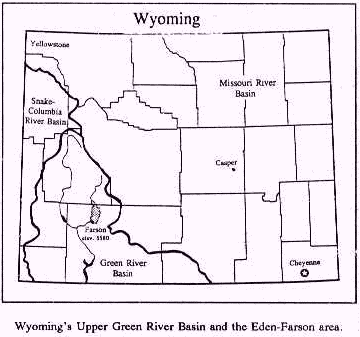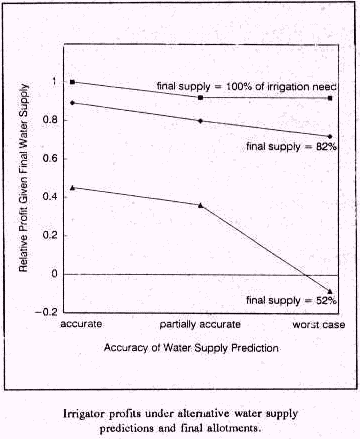Wyoming Water Resources Center

|
RESEARCH BRIEFS Wyoming Water Resources Center |

|
| Technical RB93-04 |
Investigators: James F. Booker and Ari M. Michelsen, Department of Agricultural Economics and Wyoming Water Resources Center, University of Wyoming.
Purpose: The general problem of irrigation management under limited water supplies has been extensively studied, but little work has formally addressed the sequential and uncertain nature of farm production decisions. If the annual water supply is an allotment from storage, then each decision to irrigate can be considered one of irreversible investment. The objective of this research is to better understand these investment decisions when water supplies and related weather conditions are uncertain.
Methods:
A mathematical modeling technique know as discrete stochastic programming is
used to simulate irrigators' water management decisions under uncertainty.
 This approach improves upon others used to estimate drought damages by
explicitly recognizing that cropping and management decisions must be made
with only imperfect knowledge of water supply conditions and future
weather conditions. In the example presented here, we apply this technique
to the Eden-Farson region of Wyoming's Green River Basin. Irrigation water
is derived from snowpack in the Wind River Mountains and is delivered by
the Eden Valley Irrigation and Drainage District from storage in the Big
Sandy and Eden Valley Reservoirs. Alfalfa hay and grass hay are the
dominant crops. Fertilizer and irrigation decisions must be committed
before the annual water allotment is known with certainty.
This approach improves upon others used to estimate drought damages by
explicitly recognizing that cropping and management decisions must be made
with only imperfect knowledge of water supply conditions and future
weather conditions. In the example presented here, we apply this technique
to the Eden-Farson region of Wyoming's Green River Basin. Irrigation water
is derived from snowpack in the Wind River Mountains and is delivered by
the Eden Valley Irrigation and Drainage District from storage in the Big
Sandy and Eden Valley Reservoirs. Alfalfa hay and grass hay are the
dominant crops. Fertilizer and irrigation decisions must be committed
before the annual water allotment is known with certainty.
We assume that irrigators seek to maximize profit over the range of possible irrigation supplies in their choice of fertilizer use and their water management decisions. Fertilizer applications are chosen based on snowpack estimates available in early March. The irrigation season is represented by a first and second irrigation. The level of irrigation and its allocation among hay stands during the first irrigation uses a forecast of the yearly water allotment provided mid-May by the irrigation district. Decisions in the second irrigation period make use of the final water allotment for the year; thus there is no uncertainty in this final period.
 Results:
Irrigator profit, as expected, is greatest when full water supplies are
available and there are no surprises. This outcome occurs when full
supplies are anticipated (because of high snowpack, for example) at the
time fertilization and initial irrigation decisions are made, and full
supplies are in fact realized during the final irrigation. Under drought
conditions (less than full supplies are realized) or when surprises occur
(forecasts are incorrect) profit will be reduced. The graph shows the
proportion of the maximum profit level for a range of possible conditions.
The greatest reduction in profit occurs when predictions are not accurate
and water supplies are unexpectedly found to be inadequate (worst case -
right hand side of graph). Even with hay crops it is clearly good
management to withhold some water, if possible, until late in the season
to ensure that the best stands receive full irrigation.
Results:
Irrigator profit, as expected, is greatest when full water supplies are
available and there are no surprises. This outcome occurs when full
supplies are anticipated (because of high snowpack, for example) at the
time fertilization and initial irrigation decisions are made, and full
supplies are in fact realized during the final irrigation. Under drought
conditions (less than full supplies are realized) or when surprises occur
(forecasts are incorrect) profit will be reduced. The graph shows the
proportion of the maximum profit level for a range of possible conditions.
The greatest reduction in profit occurs when predictions are not accurate
and water supplies are unexpectedly found to be inadequate (worst case -
right hand side of graph). Even with hay crops it is clearly good
management to withhold some water, if possible, until late in the season
to ensure that the best stands receive full irrigation.
Future Research: This research is part of a study to quantify the economic damages of drought affecting agriculture in Wyoming's Upper Green River Basin. It is also an important element of a broader effort to investigate the impacts of a severe and sustained drought in the full Colorado River Basin.
Publications: Booker, J., F. Briand, and A. Michelsen. "Sequential Irrigation Decisions with Stochastic Water Supply." Western Agricultural Economics Association Annual Meeting, Colorado Springs, Colorado (1992).
Briand, F., J. Booker, and A. Michelsen. "Water Supply Uncertainty and its Impacts on Profits: Eden-Farson Hay Producers." Fifth Annual Meeting, Wyoming State Section of the American Water Resources Association, Laramie, Wyoming (1992).
| The Wyoming Water Resources Center publishes two series of RESEARCH BRIEFS. The more technical series is designated by Technical in front of the RESEARCH BRIEF publication number. For further information on this or other research projects or for a list of WWRC publications, telephone or write: |
Wyoming Water Resources Center P.O. Box 3067, University of Wyoming Laramie, WY 82071-3067 (307) 766-2143; FAX (307) 766-3718 |
RESEARCH BRIEFS are published by the Wyoming Water Resources Center with funds provided in part by the US Geological Survey, Department of Interior, as authorized by the Water Resources Research Act of 1984. The research on which this report is based was financed in part by the US Geological Survey, Department of Interior and Wyoming Water Resources Center. The views expressed do not necessarily represent those of the Department of Interior or the WWRC. Persons seeking admission, employment, or access to programs at the University of Wyoming shall be considered without regard to race, color, national origin, sex, age, religion, political belief, handicap, or veteran status.
 |
Technical RB93-04 |
Research Briefs List
Water Resources Data System Library |
Water Resources Data System Homepage